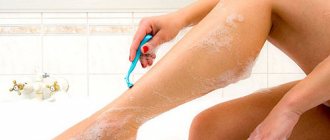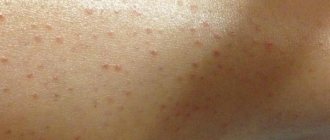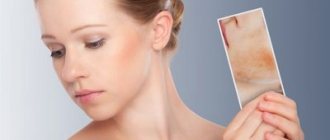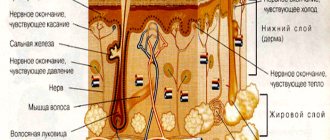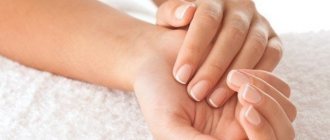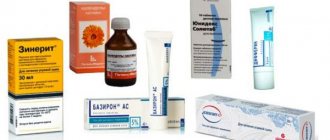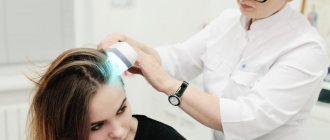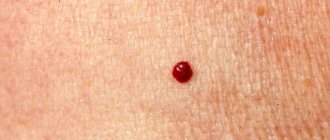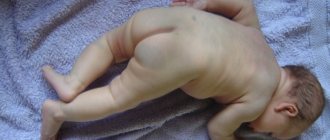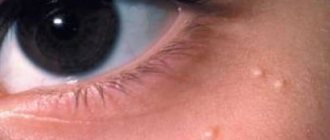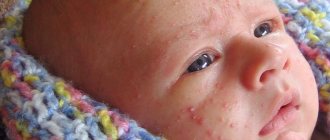Causes of the disease
All forms of dermographism, including red, have not been sufficiently studied, and their exact causes have not been established.
The disease itself is not life-threatening, but it creates significant discomfort for the sick person due to its external unattractiveness and severe painful and itchy sensations in the affected areas. If we talk about the origin of such signs, the most common is red dermographism, the causes of which are allergic in nature. In second place are disorders of the digestive tract, including:
- dysbacteriosis;
- gastritis;
- frequent constipation;
- parasitic infestations.
Also, the problem can be caused by gluten intolerance, thyroid diseases, and psycho-emotional overload.
Provoking factors for the appearance of mechanical urticaria can be:
- emotional instability;
- constant skin irritation from tight or rough clothing;
- exposure to extreme environmental temperatures;
- Exceeding the duration of treatment with certain medications;
- chronic alcohol or chemical intoxication;
- unfavorable environment.
The manifestations themselves in the form of red stripes on the body are formed due to increased skin sensitivity. It reacts to the slightest friction or contact by dilating capillaries and releasing histamine, which leads to swelling of the skin surface. This mechanism is very similar to the development of an allergic reaction, so symptoms when they first appear are often perceived as the consequences of an allergy.
Skin diseases
Skin dermographism
For most of us, the word "inscription" is associated with a wall. And some people can easily write something on their own skin with a fingernail or a sharp object. In medical parlance, this phenomenon is called dermographism, which literally means “writing on the skin”, and refers to the most common form of urticaria - body urticaria. The cause is histamine, the same substance that causes a runny nose and sneezing in allergies, which is released when pressure is applied to the skin. Histamine causes itching, redness and tingling. In response to light scratching, an itchy red mark remains on the skin that does not go away for several hours.
Although dermographism can affect anyone, it most often affects young people. Sometimes this is a sign of stress, thyroid dysfunction, or a viral infection.
Striae stretch marks
If the lines on the skin are parallel, pink, purple or white in color and do not disappear over time, these may be stretch marks - stretch marks. Most often they form on the abdomen, buttocks, chest, thighs and arms. As their name indicates, these lines appear when there is sudden rapid or prolonged stretching of the skin.
Similar phenomena are observed in rapidly growing adolescents or people who have gained weight dramatically. 90% of pregnant women have stretch marks. Bodybuilders develop stretch marks on their shoulders. If these lines appear on the face or other parts of the body, it may be due to long-term use of oral or topical corticosteroids. In addition, stretch marks can be a sign of diabetes, Ehlers-Danlos syndrome (EDS) or Cushing's syndrome.
Recent studies have shown that women with stretch marks—whether from pregnancy or obesity—are at risk of pelvic organ prolapse later in life. This disorder is caused by a weakening of the supporting structure of the pelvis, resulting in pressure, pain and problems with urination and bowel movements. Some women see something peeking out of their vagina.
Causes of stretch marks in teenagers
Why can girls and boys develop stretch marks? Adolescence is a time when rapid weight gain and body growth are also accompanied by a hormonal surge. Due to the fact that the skin quickly stretches, the epithelium ruptures. The result is the appearance of red and purple stripes on the teenager’s body, which are called stretch marks (striae). After some time, the color of the stretch marks changes to white, but against the background of tanned skin they are very noticeable.
Stretch marks are equally likely to appear in girls and boys. They most often occur on the abdomen, thighs, legs and butt due to increased muscle mass. In girls during this period, the mammary glands begin to grow, which contributes to the formation of stretch marks on the chest.
The reasons for the appearance of stretch marks on the body can be different. The main ones:
- A sudden weight gain or growth spurt leads to thinning of the skin and cracks. These cracks are then filled with connective tissue and red and purple stripes appear.
- Weight gain, caused by hormonal changes or a sedentary lifestyle, also contributes to the appearance of stretch marks on the legs, thighs, butt or abdomen.
- A weakened immune system will sooner or later cause the skin to become less elastic and tears to occur.
- Heredity. The predisposition to developing stretch marks in a child can be passed on from parents. In this case, it is worth taking preventive measures as early as possible.
- Lack of muscle mass with rapid bone growth is the cause of the formation of stretch marks on the back. If a teenager feels pain, then it is worth seeing a doctor as soon as possible. Displacement of the vertebrae may occur.
If your child begins to grow rapidly, be sure to warn him about the possibility of stretch marks appearing on his legs, stomach or butt.
You can, for example, show a photo so that he knows what they look like and immediately turns to you the first time he appears. Explain that there is nothing wrong with this and stretch marks can be treated.
Prevention and prognosis
You can prevent the development of symptoms if you adhere to the following rules:
- choose soft washcloths for hygiene procedures;
- refuse massage;
- dry yourself with soft (preferably bamboo) towels;
- wear clothes that fit properly and without tight seams;
- do not scratch your body after bites or other injuries;
- choose backpacks with wide straps and bags with comfortable handles;
- give up woolen clothes and clothes made from thick materials, give preference to cotton;
- adhere to a certain daily routine and healthy diet;
- wash fruits, berries and vegetables thoroughly before eating;
- Avoid stressful situations if possible.
The prognosis of dermographism is often favorable. With proper treatment of it and associated diseases, absolute recovery is possible.
It is known that during the night a sleeping person can change his body position, on average, up to 20 times. Moreover, more than a third of night sleep is spent in the position on the back, the rest of the time - on the sides and stomach. In fact, the favorite sleeping position determines the nature of the formation of wrinkles on the face. Published on the web portal
Considering that women like to sleep on their sides, and men like to sleep on their stomachs. Accordingly, wrinkles after sleep in women are more often noticeable on the jawline and cheeks, while in men, the face is pressed tightly to the pillow, and “sleep wrinkles” form on the forehead. According to doctors, the only possible way to get rid of sleep wrinkles is to force yourself to sleep on your back!
Regardless of what position we sleep in at night, the amount of hyaluronic acid in the deep layers of the skin decreases after 25 years, which leads to a decrease in skin elasticity and the formation of age-related wrinkles and folds on the face. If we sleep face down or put our fist under our cheek so that it “slides” almost into our eyes, we spend 8 hours a day creating wrinkles on our face!
Wrinkles between the cheek and the back of the nose, between the lower lip and chin, wrinkles across the crow's feet, worsening nasolabial folds, as well as various creases of the most bizarre shapes and sizes - most often this is the result of a night's sleep, during which the skin shifts, breaks or flattens.
Sleeping on your stomach
The worst position is sleeping on your stomach with your face pressed to the pillow. Have you noticed vertical lines or fabric marks on your face after sleeping? If so, then you are looking at only a preliminary version of permanent wrinkles that are already forming. Those who prefer to sleep on their stomach often suffer from forehead wrinkles.
Sleeping on your side
Research shows that a person spends an average of 60% of their night sleeping on their side. This position creates vertical lines on the cheeks and chin. Sleeping in this position also aggravates the condition of facial wrinkles (especially glabellar folds and wrinkles around the lips). If you prefer to sleep on one side, it will quickly become clear which one. You can soften the effect a little by constantly changing sides, but this is still not a very good option.
Sleeping on your back
The best way to avoid wrinkles is to eliminate any contact between your face and the pillow, which means sleeping on your back. In addition, you will get rid of rashes that are caused by bacteria living on the pillow, as well as puffy eyes in the morning, since the normal outflow of fluids on your face will remain throughout the night.
Symptoms
The main signs of red dermographism appear externally on the skin, but at the same time they are almost always accompanied by a deterioration in health. General symptoms of the disease include:
- the appearance of swollen red or pink stripes at the site of the streak effect on the skin;
- the appearance of itchy rashes in the form of small rashes or blisters on the affected area;
- development of physical and psychological exhaustion.
Red welts, swelling, itching, burning and rashes develop even with minor friction and last from several hours to several days. In most cases, these symptoms appear and disappear suddenly. The most unpleasant thing is that symptoms that appear at least once can continue to manifest themselves throughout life, without affecting its duration, but significantly reducing its quality.
In addition, when scratching itchy, inflamed areas, the integrity of the skin is disrupted, which is dangerous due to infection. A constant feeling of severe discomfort and deterioration in appearance can cause serious psychological problems. Therefore, the disease requires mandatory competent diagnosis and subsequent adequate treatment.
Signs of dermographism
With white dermographism, after running a stick with a blunt end over the skin, a white stripe immediately appears, disappearing after a few minutes. If the stick is applied with great pressure on the skin, a red stripe is visualized, which will disappear only after a few hours, which is a manifestation of red dermographism.
Severe mechanical irritation of the skin with a stick with a blunt end can provoke edematous dermographism. In this case, first a red stripe forms in the area of direct contact of the skin with the stick, which after 2–3 minutes turns white, swells and swells.
Urticarial dermographism is caused by increased permeability of the vascular walls. As a result, even minor irritation of the skin, such as from the elastic of socks or a trouser belt, leads to the formation of a red stripe surrounded by blisters and a rash.
If you run a sharp needle across the skin, within half a minute a wide red stripe will appear on the surface of the skin. After a few seconds she turns pale and disappears. This is a manifestation of reflex dermographism.
What solution do cosmetologists offer?
Having learned why stretch marks form in teenagers, you should immediately begin procedures that will help eliminate them: the sooner, the greater the chance of eliminating skin defects. You should not hope that the treatment will go quickly. As a rule, it takes more than a month. There are different methods: both traditional medicine and folk methods.

There are 3 effective methods that will help cure stretch marks:
- Mesotherapy is quite effective in combating skin defects, painless and safe. Using thin needles, the doctor injects drugs that speed up the skin restoration process. The procedure is usually carried out 2 times a month, and the course itself will take up to six months. It must be remembered that this type of therapy is contraindicated if the teenager has infectious and inflammatory processes.
- Laser resurfacing is an expensive procedure, but after the first session, some stretch marks disappear. It usually lasts for an hour, and after completion there is slight redness and burning on the thighs, legs, butt and other parts of the body. The effectiveness is very high: after a couple of weeks, all defects can be completely eliminated.
- Cosmetic preparations - ointments and creams that contain collagen and silicone, will also help in the fight against stretch marks, as they accelerate skin regeneration. Before use, it is necessary to check whether the child is allergic to the components of the drug.
How to remove stretch marks on legs in adults
You can remove stretch marks on the legs around the knees in adults using modern clinical and salon techniques and cosmetic products:
- Laser therapy. Fractional lasers reduce stretch marks and sometimes remove them completely. A course is required to achieve the desired effect. The number of procedures depends on the severity of the condition and the type of skin.
- Cosmetics. The modern market offers various cosmetic products used to combat stretch marks. Experts note that medicinal cosmetics help in the initial stages and during prevention.
- Mesotherapy. This method is considered the most popular and effective. The specialist prepares a medicinal mixture, injected under the skin with a special roller with thin small needles. Mesotherapy normalizes the production of collagen and elastin to eliminate stretch marks.
- Cosmetic surgery. Surgery is required for large stretch marks and sagging skin.
- Chemical peeling. In this procedure, chemicals are applied to the skin, after which the skin dies and heals. The dying process is required for further active reproduction of healthy skin cells.
The above methods help to successfully get rid of stretch marks for adults and adolescents.
Diagnosis of pathology and causes
Red dermographism itself is diagnosed quite simply, since it is characterized by pronounced manifestations on the skin. It is enough for the doctor to conduct an examination and perform a mechanical test - run a dermographometer or simply a thin blunt object over the patient’s body. The result is assessed after 10 minutes and allows you to determine the presence of pathology with absolute accuracy.
However, dermographic urticaria is extremely rarely an independent disease. Therefore, for effective treatment it is necessary to identify and eliminate its root cause. Diagnosis of concomitant diseases includes laboratory blood tests, collection of medical history and examination (most often differential) for the presence of the underlying disease.
To identify it, the following are additionally prescribed:
- ultrasound examinations of internal organs;
- tests for parasitic infestation;
- hormonal studies;
- encephalogram, tomography, radiograph;
- biopsy of various tissues;
- checking the state of immunity.
The treatment plan is prescribed depending on the results obtained and the identified pathology.
Folk recipes
Traditional methods of combating stretch marks can be combined with folk recipes. Wraps with honey and aloe are very helpful for stretch marks on the hips, legs, butt and stomach.
You need to take 5 tablespoons of honey and aloe (porridge), mix with 100 ml of warm water and divide into 2 parts. Freeze one in an ice cube tray, and apply the other to the skin after taking a shower and wrap in film. After an hour, rinse everything off with water and wipe the skin with prepared cubes of the frozen mixture. After drying, additionally lubricate the skin with a cream containing collagen or silicone. Repeat the procedure every day for a month.
A paste of cucumbers and oatmeal, rubbed into the skin within half an hour after a shower, will also be effective.
Treatment
When treating dermographic urticaria, elimination of its external manifestations is necessarily carried out simultaneously with therapy aimed at getting rid of their cause, that is, the underlying disease. If the precipitating factor cannot be identified, persistent red dermographism may not be completely curable throughout life. In such situations, it is necessary to maintain it within normal limits using conservative or alternative methods.
Drug treatment involves taking several groups of drugs:
- antihistamines - Claridol, Clarisens, Suprastin, Fenkarol;
- vasoconstrictors – “Troxevasin”, “Ascorutin”, isoflavonoids;
- relieving swelling - “Lioton-1000”, troxevasin ointment, “Heparin”;
- antipruritic - “Panthenol”, “Fenistil-gel”, “Skin-up”, “Gistan”;
- to restore intestinal microflora - “Acilact”, “Narine”, “Bifiliz”, “Biovestin-lacto”;
- choleretic - “Cholenzim”, “Vigeratin”, “Hologon”, “Decholin”.
In serious cases, hormonal agents based on hydrocortisone are used. In addition, an individual treatment regimen is prescribed depending on the identified cause of symptoms.
Folk recipes
Traditional medicine very effectively eliminates all external signs of dermographic urticaria, relieving itching, redness, inflammation and swelling. The following recipes are considered the most effective:
- Nettle decoction – 100 g of herb per 1 liter of water, boil for 5 minutes, cool, filter. Wash affected skin as often as possible.
- Decoction of raspberry rhizomes - 25 g of raw material per 1 glass of water, boil for 15 minutes, cool, filter. Drink at a time, prepare and take daily.
- Herbal decoction - pour the same amount of medicinal chamomile, valerian, sage, string, St. John's wort, celandine with water so that it completely covers the herbs. Boil for 15 minutes, cool, filter. Add the resulting decoction to the water when taking a bath. The procedure must be carried out every day until the symptoms disappear. It helps very well to relieve symptoms even with persistent red dermographism. It is also recommended to regularly wash the affected areas with this decoction (or just a few herbs).
- Olive oil – moisten the painful areas with heated oil.
- Raw potatoes - wrap the grated mass in a thin cloth, apply several times a day.
- Sea salt (pure, without additives) – 100 g per 10 liters of warm water, take a bath. After the procedure, do not wash off the salt; pat your body gently with a soft towel.
When choosing this or that plant material, you must take into account the likelihood of an allergic reaction, so as not to aggravate the situation.
Most skin problems in humans directly depend on nutrition, eating habits and the quality of the digestive system. Therefore, if red dermographism manifests itself, you definitely need to reconsider your diet so that it is healthy and balanced. In addition, a lack of vitamins, minerals, and other substances necessary for the body leads to a significant decrease in immunity, against the background of which dermographic urticaria most often develops.
The diet for red dermographism is based on compliance with the following rules:
- complete exclusion from the diet of all aggressive foods - salty, spicy, fried, smoked, etc.;
- minimizing or completely abstaining from alcoholic beverages;
- consumption of predominantly plant foods with a predominance of fresh vegetables, herbs, fruits (except for those that are highly allergenic - strawberries, citruses, grapes, etc.);
- introduction of lactic acid products into the daily diet.
In many cases, dermatological problems can be successfully corrected if you start eating right. It is especially important that the body receives:
- vegetable fiber necessary for normalizing digestive processes and cleansing the intestines;
- lactic acid products that help maintain intestinal microflora and normalize stool.
Such nutrition should not become a diet, but a way of life. It should be followed for life immediately after signs of red dermographism appear. If the causes of the pathology are not serious diseases of the internal organs, then correct adjustment of the diet will help to quickly improve your well-being and general health.
Symptoms of skin diseases
Thick, rough skin is a symptom of what disease?
If your skin feels like it has become thicker and tighter, this could be a sign of a serious autoimmune disease called scleroderma. Translated from Latin, this name sounds like “rough skin.” The pathology is caused by increased production of collagen in the body. Scleroderma is a chronic connective tissue disease that affects the skin on the face, hands and fingers, where it becomes denser and rougher. Unfortunately, damage to joints and internal organs sometimes occurs. Symptoms of scleroderma often accompany Raynaud's disease, in which the fingers and palms become bluish.
Scleroderma, or systemic sclerosis, occurs four times more often in women than in men. The mildest form is called limited scleroderma, in which the skin of the face and fingers becomes shiny and feels tight.
Telangiectasia (dilation of small blood vessels) is another common symptom of limited scleroderma.
Diffuse scleroderma is a more severe form of this disease; it affects the most important internal organs. And it often causes serious problems in the gastrointestinal tract or when swallowing food, and this is a direct threat to life.
The acronym for the main signs of scleroderma in English is CREST:
- C: calcium deposits - excess calcium under the skin and in the body;
- R: Raynaudsdisease - Raynaud's disease;
- E: Esophagealdysfunction - disturbances in the functioning of the esophagus;
- S: Skindamage - skin lesions on the fingers and toes (sclerodactyly);
- T: Telangiectasia - dilated blood vessels.
Red or purple dense spots are symptoms of what disease?
Dense or hard, oval-shaped, red or purple spots may well be a symptom of morphea, a rare autoimmune pathology that usually occurs on the trunk and limbs. In some cases, these spots gradually turn yellow, leaving a white dot in the middle. Sometimes they look like an incompletely healed scar or burn. Morphea (from the Greek word for "shape") is a localized variant of scleroderma, an autoimmune disease that causes severe negative changes in internal organs. In contrast, morphea affects only the skin, without affecting other organs. But, as with scleroderma, in the case of morphea, the skin becomes dense, hard, rough, less flexible, and this affects dexterity and mobility.
Red skin on the legs is a symptom of what disease?
Sometimes the skin on the legs turns red due to allergies. In this case, naturally, the allergen that affects the skin is excluded. These could be medications, vitamins, sun rays, synthetic materials, etc. Treatment includes taking antihistamines prescribed by your doctor.
Red spots on the legs can even appear due to poor nutrition. If you overuse flour, sweet, and smoked foods, your body hardly likes it, and it begins to work unstably. As a result, redness may occur on any part of the body. Remember that skin problems are often an indicator of what is happening in the internal organs. What to do? Just eat right, include more vegetables, fruits, complex carbohydrates, and protein in your diet.
Stress is another cause of redness. As a result, so-called “nerve” spots appear. Just stop being nervous and the problem will disappear. To do this, drink herbal infusions or sedative medications. Motherwort or valerian will do. Rest more often and don’t worry about trifles - health is more valuable.
Heredity also plays an important role in all those features that are inherent in the human body. It may turn out that the body is genetically predisposed to redness in the leg area. There's nothing you can do about it - you'll just have to constantly care for this area to minimize the appearance of redness.
Redness of the skin on the legs can be associated with a burn: solar, thermal, chemical. The main task in this case is to cope with the problem as quickly as possible and restore the natural state of the skin. For this, ointments and creams are used (for example, the well-known panthenol), as well as folk remedies (raw potatoes, etc.).
The skin in the leg area may also turn red from frostbite. In this case, you just need to warm up as soon as possible.
Take care of yourself and be healthy!
29-11-2007, 02:37
Dear girls, help me out! I'm 31 weeks and it's been such crap lately! :010: When you press on the leg, there are no indentations that indicate swelling, but just white spots! :001: After 5 seconds, the white spot disappears, and this place again acquires a flesh-colored, slightly pinkish tint. This has never happened before... It started a couple of weeks ago. There is pathological weight gain... Really pathological!
WHAT CAN THIS INDICATE?
P.S. There are a lot of similar topics here, but we are talking everywhere about ordinary edema... But for me, it seems, there are hidden ones... Or not edema at all:009: So don’t throw tomatoes at creating a clone topic :)) This is not true :)
29-11-2007, 09:24
Well, these are just not even hidden swellings. Limit yourself to liquids. Try sitting on apples or buckwheat for a day. It's difficult, but possible.
29-11-2007, 20:26
Girls, thank you all for the correct diagnosis! I didn’t even really understand what kind of spots they were, and therefore didn’t know how to treat them. Now I will fight swelling...
30-11-2007, 04:00
Swelling and nothing else
30-11-2007, 04:16
30-11-2007, 09:40
One thing is interesting to me: why don’t I still have the famous “dimples” after pressing? The skin is absolutely smooth! Or “white spots are the initial stage” of edema, and dimples are already advanced? :008:
I don't have dimples either, just spots. dimples are apparently true when it’s really bad...
30-11-2007, 10:08
One thing is interesting to me: why don’t I still have the famous “dimples” after pressing? The skin is absolutely smooth! Or “white spots are the initial stage” of edema, and dimples are already advanced? :008: white spots are the initial stage, so even doctors check every time they come, they press and see whether the spot is white or not. It is necessary to limit the fluid. I remember once I was also prescribed a diet somewhere during this period - in one day, eat 1 kg of apples and 1 kg of carrots and try not to drink anything
30-11-2007, 11:00
30-11-2007, 11:28
Listen, I also have white spots after pressing, but they disappear immediately, not after 5 seconds. Is this also swelling?????
Glumyrga
30-11-2007, 12:40
I would still ask the doctor. because when you press on the skin, it follows from logic and anatomy that you block the blood flow in the capillaries for some time. accordingly, white spots appear. removed the finger - the blood flow was restored - the stain went away.
30-11-2007, 14:59
The doctor told me that if you hold on for more than 2-3 seconds, then this is swelling. I tested it on my husband, and it definitely goes away instantly for him, but I only have 3-5 seconds left. I also suffer, it started after 30 weeks. I tried a bunch of things, Canephron and tea and fruit drinks and a day hospital, they’ll take it away for a while, and then again. They said you’ll give birth and everything will pass, so I’m waiting. Although it has gotten better now, the water is slowly going away.
30-11-2007, 17:42
but I thought this was a normal reaction of the skin to pressure - the appearance of a white spot that goes away in 3-5 seconds. How long does the spot last if it is swelling?? For me the spot lasts 5-6 seconds
Listen, I also have white spots after pressing, but they disappear immediately, not after 5 seconds. Is this also swelling????? This is probably normal. So I tested it on my husband, everything disappears in a second! And I still have 5-6... And the spot is so white! There is such a contrast compared to other areas of the skin.
30-11-2007, 18:09
I would still ask the doctor.

Red dermographism is a phenomenon that sometimes may not receive due attention for a long time. This skin disease is often not given much importance. At the same time, cutaneous dermographism (although this is a little-studied and, for the most part, not dangerous disease) can cause noticeable discomfort to young people. Since human skin is the main indicator of the state of the body, the symptoms of red dermographism are important to take into account.
